The Union Cabinet chaired by the Prime Minister recently approved the National Sports Policy (NSP) 2025.
About National Sports Policy 2025
- The new policy supersedes the existing National Sports Policy, 2001
- It lays out a visionary and strategic roadmap to establish India as a global sporting powerhouse and a strong contender for excellence at international sporting events, including the 2036 Olympic Games.
Key Features of NSP 2025
The policy is anchored on five key pillars.
- Excellence on the Global Stage: To build India as a global leader in sports by nurturing talent and improving sports infrastructure.
- Grassroots Development: Establish a robust system for identifying and nurturing young talent.
- Sports Infrastructure: Develop world-class sports facilities in rural and urban areas.
- Sports Science & Technology: Integrate sports science, medicine, and technology to enhance athlete performance.
- Capacity Building of Sports Federations: Improve governance and operational capabilities of National Sports Federations (NSFs).
- Sports for Economic Development: Utilize the economic potential of sports to boost growth in various sectors.
- Sports Tourism: Promote India as a hub for international sporting events.
- Sports Manufacturing: Strengthen the sports equipment and technology ecosystem.
- Startups & Entrepreneurship: Support sports-related startups and innovation in the sector.
- Private Sector Engagement: Increase private investment through Public-Private Partnerships (PPPs) and Corporate Social Responsibility (CSR).
- Sports for Social Development: Use sports to foster social inclusion and community development.
- Inclusive Participation: Focus on women, economically weaker sections, tribal communities, and persons with disabilities.
- Promotion of Indigenous Sports: Revitalize traditional games and indigenous sports.
- Career Opportunities in Sports: Make sports a viable career choice, integrating it into the education system.
- Diaspora Engagement: Involve the Indian diaspora in sports development.
- Sports as a People’s Movement: Make sports a part of the cultural fabric of the nation through mass participation.
- Fitness Culture: Drive a nationwide movement for fitness and healthy living.
- Nationwide Campaigns: Launch campaigns to increase participation in sports at all levels.
- Fitness Indices: Introduce fitness tracking for schools, colleges, and workplaces.
- Access to Sports Facilities: Ensure universal access to sports infrastructure.
- Integration with Education (NEP 2020): Align sports development with the National Education Policy (NEP) 2020 to foster physical fitness from an early age.
- Curriculum Integration: Include sports in school curricula to encourage physical activity and sports awareness.
- Teacher Training: Equip educators and physical education teachers with the necessary skills to promote sports.
Implementation Strategy: A comprehensive implementation strategy to achieve the goals of NSP 2025
- Governance: Establish a robust legal and regulatory framework to ensure effective sports governance.
- Private Sector Support: Leverage private sector involvement through innovative financing mechanisms.
- Technology & Innovation: Use emerging technologies like AI and data analytics for performance tracking and program implementation.
- National Monitoring Framework: Develop benchmarks, Key Performance Indicators (KPIs), and time-bound targets to track progress.
- State-Level Policies: Encourage States and Union Territories to formulate policies aligned with NSP 2025.
- Whole-of-Government Approach: Integrate sports into the activities of all Ministries and Departments.
India’s Sports Policy Journey
- Early Sports Development Post-1947: Post-independence, India’s primary focus was on nation-building, addressing issues like poverty, health, and education, which sidelined sports development.
- Key Event: India hosted the first Asian Games in 1951 in New Delhi, marking its regional aspirations. However, sports development remained modest.
- Establishment of AICS (1954): The All-India Council of Sports (AICS) was set up to advise on sports matters but lacked substantial funding, limiting India’s athletes from competing internationally.
- 1982 Asian Games and Policy Shifts:
- Department of Sports Creation (1982): The creation of the Department of Sports under the Ministry of Human Resource Development in 1982 marked a turning point.
- National Sports Policy (NSP) 1984: Aimed to improve infrastructure and promote mass participation and excellence in elite sports, alongside integrating sports with education.
- Sports Authority of India (SAI) (1986): Established to implement sports policy and focus on athlete development.
- Stagnation Between 1986-2000: Despite global sports ecosystems evolving during this period, India’s sports policy remained tepid due to:
Constitutional Context:
- Sports as a State Subject in Seventh Schedule.
- Entry 33 of the State List and the Indian Constitution
|
-
- Limited state-level involvement: Sports was a State subject under the Indian Constitution.
- Weak policy execution: Policies remained weak, and implementation was inconsistent.
- Economic Liberalization (1991) led to greater global exposure and changed attitudes towards sports, but the NSP draft (1997) failed to gain traction.
- Post-2000 Sports Development:
-
- Creation of MYAS (2000): India created the Ministry of Youth Affairs and Sports (MYAS) to streamline sports development.
- NSP 2001: A revised National Sports Policy set clearer goals for mass participation and international excellence. However, funding remained limited.
- Key Achievements:
- Olympic Medals: Rajyavardhan Rathore (silver, 2004), Abhinav Bindra (gold, 2008), and Vijender Singh and Mary Kom (bronze in 2008 and 2012 respectively).
- NSDC 2011: Introduced to regulate sports federations, focusing on governance, anti-doping, and issues like age fraud and gender equality.
Importance of Sports to Economic and Social Development
- Revenue Generation and Economic Growth: Sports events drive significant revenue through media rights, sponsorships, and tourism.
- For instance, For instance, the Tokyo 2020 Olympics contributed approximately $8 billion to Japan’s economy.
- Infrastructure Development and Job Creation: Hosting major events necessitates infrastructure upgrades, leading to long-term benefits.
- Qatar’s government has spent more than $300 billion on infrastructure projects, including highway and airport expansions for the 2022 FIFA World Cup.
- Brazil’s 2014 FIFA World Cup created over 3 million jobs and invested in stadium construction and transportation systems.
- Health Benefits and Reduction in Healthcare Costs: Regular physical activity through sports reduces the risk of chronic diseases and cuts healthcare costs.
- The WHO attributes over 5 million deaths annually to physical inactivity, highlighting the importance of sports in preventing such conditions.
- Social Cohesion and Integration: Sports promote unity by bringing people from diverse backgrounds together.
- The 2010 FIFA World Cup in South Africa was a key event in fostering national unity post-apartheid.
- Youth Development and Education: Participation in sports enhances cognitive skills, discipline, and academic performance.
- Khelo India has established more than 1000 centres, offering training and support to grassroots athletes.
- Promoting Social Inclusion and Reducing Discrimination: Sports provide opportunities for marginalized groups to participate and gain recognition.
- Avani Lekhara’s gold medal at the Tokyo 2020 Paralympics showcased the growing inclusion of para-athletes in global sports.
- Boosting Tourism and International Investment: Hosting global sports events attracts international tourists and boosts local economies.
- The 2012 London Olympics generated £2.1 billion in tourism revenue, showing how sports events drive economic growth.
Challenges in Indian Sports
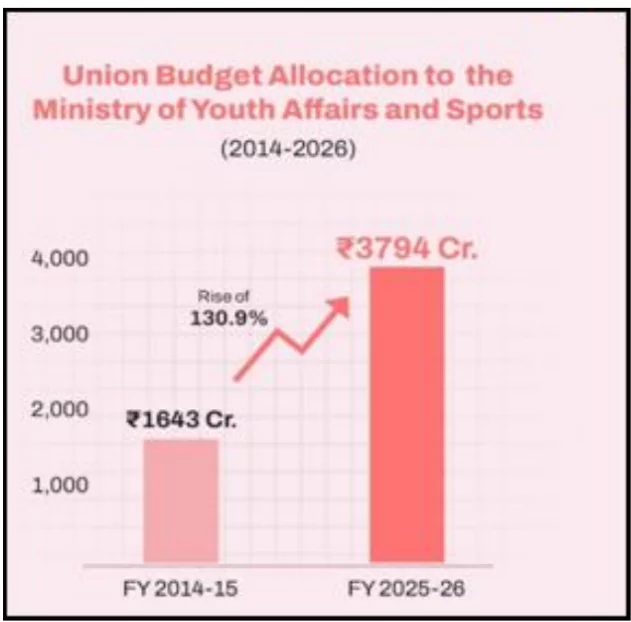
- Underdeveloped Infrastructure: Lack of world-class sports facilities, especially in rural areas, hinders grassroots development.
- Inadequate training centers, coaching infrastructure, and sports science facilities affect athlete performance.
- Talent Identification and Nurturing: Grassroots talent identification is often limited, with many promising athletes overlooked due to inadequate scouting systems and poor support at the local level.
- Despite initiatives like Khelo India, the system for identifying and developing talent remains weak, especially in non-mainstream sports.
- Funding and Sponsorship: Limited funding for most sports, with cricket taking the lion’s share of sponsorships, leaving other sports underfunded.
- The lack of private sector involvement in sports, except cricket, limits the growth of sports infrastructure and professional leagues.
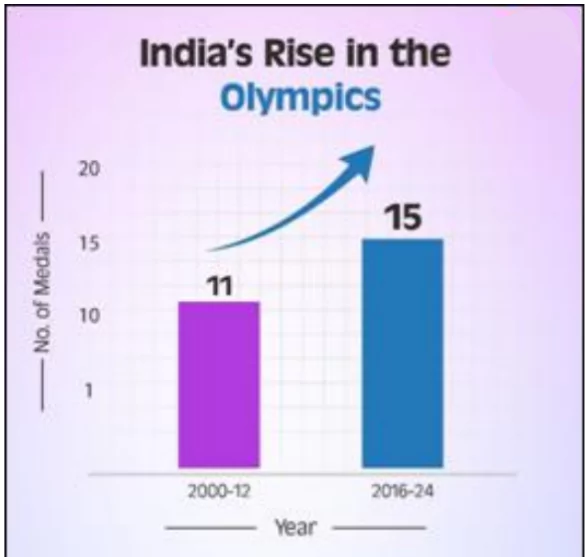 Gender Disparity: Women’s participation has been rising with the success of athletes like P.V. Sindhu and Mary Kom, but there is still a cultural and institutional bias, especially in non-mainstream sports.
Gender Disparity: Women’s participation has been rising with the success of athletes like P.V. Sindhu and Mary Kom, but there is still a cultural and institutional bias, especially in non-mainstream sports.-
- Social and cultural biases restrict women’s participation in sports.
- Poor Sports Governance: The lack of professional management and transparency in sports federations leads to poor decision-making and a lack of accountability.
- Corruption and inefficiency in sports organizations delay the development of the sports ecosystem.
- National Sports Federations (NSFs) often face criticism for poor management and lack of professionalism.
Key State-level Initiatives
- Haryana Model (Athletics and Wrestling): Haryana’s success in athletics and wrestling is supported by the state’s strong investment in sports academies and infrastructure.
- Kerala’s ‘One Panchayat, One Playground’ Initiative: Kerala’s initiative to provide one playground per panchayat ensures grassroots access to sports facilities and encourages local participation.
- Rajasthan’s Rural Olympics: Rajasthan’s Rural Olympics promote both traditional and modern sports, engaging rural communities and identifying young talent.
- Telangana: Influenced by Pullela Gopichand, has developed Hyderabad as ‘badminton capital’ with specialized training and infrastructure.
|
- Lack of Sports Culture: There is a limited sports culture, especially in education, where sports are often seen as secondary to academics.
- Social attitudes often prioritize traditional career paths like engineering or medicine, sidelining sports as a viable career.
- Other Challenges
- Socio-Economic Barriers: Many talented Indian athletes, especially in non-mainstream sports, face socio-economic constraints that limit their opportunities to train, compete internationally, and receive professional coaching.
- Narrow Focus on a Few Sports: In India, cricket dominates the sports landscape, with most resources and attention concentrated on it.
- Mentality and Lack of Sports Psychology: Sports psychology is a growing field in developed countries, helping athletes handle pressure and develop mental toughness.
- In India, the focus has traditionally been on physical training, with little emphasis on mental preparation for international competition.
Key Sports Initiatives
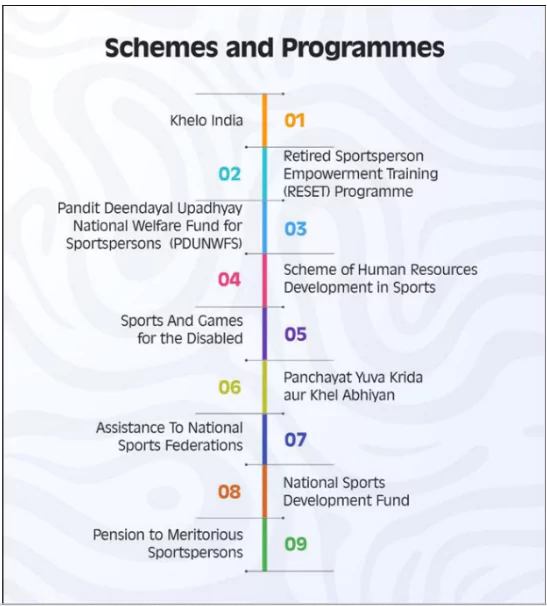
- Khelo India Scheme (Launched 2016-17): To promote mass participation and excellence in sports at the grassroots and elite levels.
- 1,045 Khelo India Centres (KICs) established for grassroots training.
- 34 Khelo India State Centres of Excellence (KISCEs) and 306 accredited academies.
- Support for 2,845 athletes, covering coaching, medical care, and allowances.
- Khelo India Games (KIYG) (2018): A set of national sports competitions to foster youth talent.
- Events:
- Khelo India Youth Games (KIYG)
- Khelo India University Games (KIUG)
- Khelo India Para Games and Khelo India Winter Games (KIWG)
- Growth:
- KIYG started in 2018 with 18 sports, expanded to 27 sports in 2025.
- 17 editions conducted with over 50,000 athletes.
- Para Games involved over 1,300 athletes in 2023 and 2025.
- KIRTI (Khelo India Rising Talent Identification) (2024): Identify and nurture sporting talent for India’s future Olympic hopes.
- Focus: Children aged 9–18.
- Methodology: Talent Assessment Centres (TACs) using AI and data analytics for transparent selection.
- Goal: Build a sustainable athlete pipeline, aiming for a top-10 global ranking by 2036.
- Target Olympic Podium Scheme (TOPS) (2014): Support India’s top athletes with financial assistance and elite training.
- Support: Funding for training, coaching, and additional needs not covered by regular schemes.
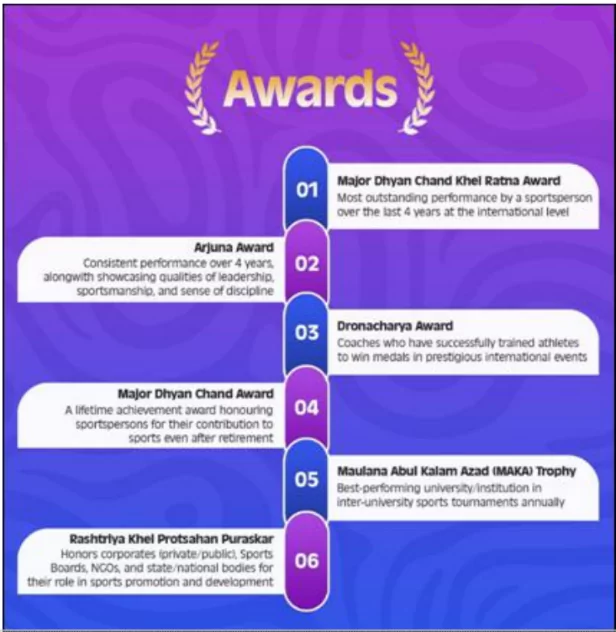 Allowances: Core group athletes receive ₹50,000/month; junior athletes in the Development Group get ₹25,000/month.
Allowances: Core group athletes receive ₹50,000/month; junior athletes in the Development Group get ₹25,000/month.- Key Contribution: Enhanced performance at the Tokyo 2020 and Paris 2024 Olympics.
- FIT India Movement (2019: Promote fitness and physical activity nationwide.
- Activities:
- Fit India Carnival (2025), a fitness and wellness festival.
- Fit India-Healthy Hindustan talk show.
- Fit India Family Sessions and nationwide Plog Runs.
- Special Package for Development of Sports Infrastructure of Jammu and Kashmir (2015): A special package of Rs. 200 crore for development of sports infrastructure in the state of Jammu & Kashmir was approved in 2015.
- Nehru Yuva Kendra Sangathan (NYKS) (1972): One of the largest youth organizations in the world, NYKS focuses on:
- Youth Engagement: Literacy, health, sanitation, women’s empowerment, and skill development.
Global Engagements and Diplomacy
- The FIFA U-17 Women’s Football World Cup 2022 was in 2022 in Bhubaneswar. This was the second major football event hosted in the last five years.
- India hosted several key international events related to sports, including:
- 141st International Olympic Committee (IOC) Session in Mumbai in October 2023.
- FIDE Chess Olympiad in Chennai in 2022.
- BIMSTEC Aquatics Championship in New Delhi in 2024.
- MotoGP Bharat in Noida in 2023.
- In 2023, the Indian Delegation led by Secretary (Sports) participated in the Seventh International Conference of Ministers and Senior Officials responsible for Physical Education and Sports (MINEPS VII) organized by UNESO in Baku, Azerbaijan.
- India’s participation was significant, with a special Yoga session was organized for the delegates.
|
Way Forward for Indian Sports
- Enhanced Infrastructure Development: Focus on creating world-class sports facilities in both urban and rural areas through Public-Private Partnerships (PPP). Special emphasis should be placed on infrastructure for non-cricket sports like athletics, football, and hockey to ensure equitable access.
- Address the infrastructure gap by ensuring sustainable development, especially in underserved regions.
- Improved Talent Identification and Grassroots Programs: Strengthen the Khelo India Scheme and KIRTI (Talent Identification) to identify athletes at a younger age, focusing on non-mainstream sports.
- Build a structured pathway for young talent to transition from grassroots to international competition.
- Increased Funding and Sponsorship: Diversify sponsorship beyond cricket and encourage private sector involvement in other sports.
- Create a more balanced funding model that can support a broader range of sports and athletes.
- Gender Equality and Social Inclusion: Ensure equal opportunities and facilities for female athletes and marginalized communities, with dedicated programs for tribal and economically weaker sections.
- Foster gender equity and inclusion across all levels of sports in India, ensuring no athlete is left behind due to socio-cultural barriers.
- Revamp Sports Governance and Accountability: Strengthen the governance framework within sports federations by promoting transparency and accountability.
- Improve management practices, reduce corruption, and increase professionalism in sports organizations, aligning them with international standards.
- Draft National Code for Good Governance in Sports, 2017 should be given the go-ahead.
- Promotion of Sports Culture: Introduce sports-centric curriculum at schools, integrate physical education from early childhood, and promote sports as a career choice.
- Cultivate a national sports culture where physical activity is celebrated, and sports are prioritized alongside academics.
- Collaboration with Global Sporting Bodies: India should form partnerships with international sports organizations and athletes’ networks to increase global exposure and learning opportunities.
- Improve the quality of training, coaching, and competitive exposure for Indian athletes on the world stage.
- Constitutional reform: Including sports in the Concurrent List will allow seamless integration of Centre and State policies, fostering coordinated development aligned with health, education, and gender equality.
- Enshrining the ‘Right to Sports’ under Article 21 will ensure that every citizen has the constitutional right to participate in sports, facilitating equitable access across India.
Conclusion
The National Sports Policy 2025 provides a comprehensive roadmap for transforming India into a global sports leader. However, a concerted effort to improve infrastructure, funding, governance, and inclusivity is needed to overcome existing challenges and help India perform at its best in the 2036 Olympics and beyond.
![]() 2 Jul 2025
2 Jul 2025
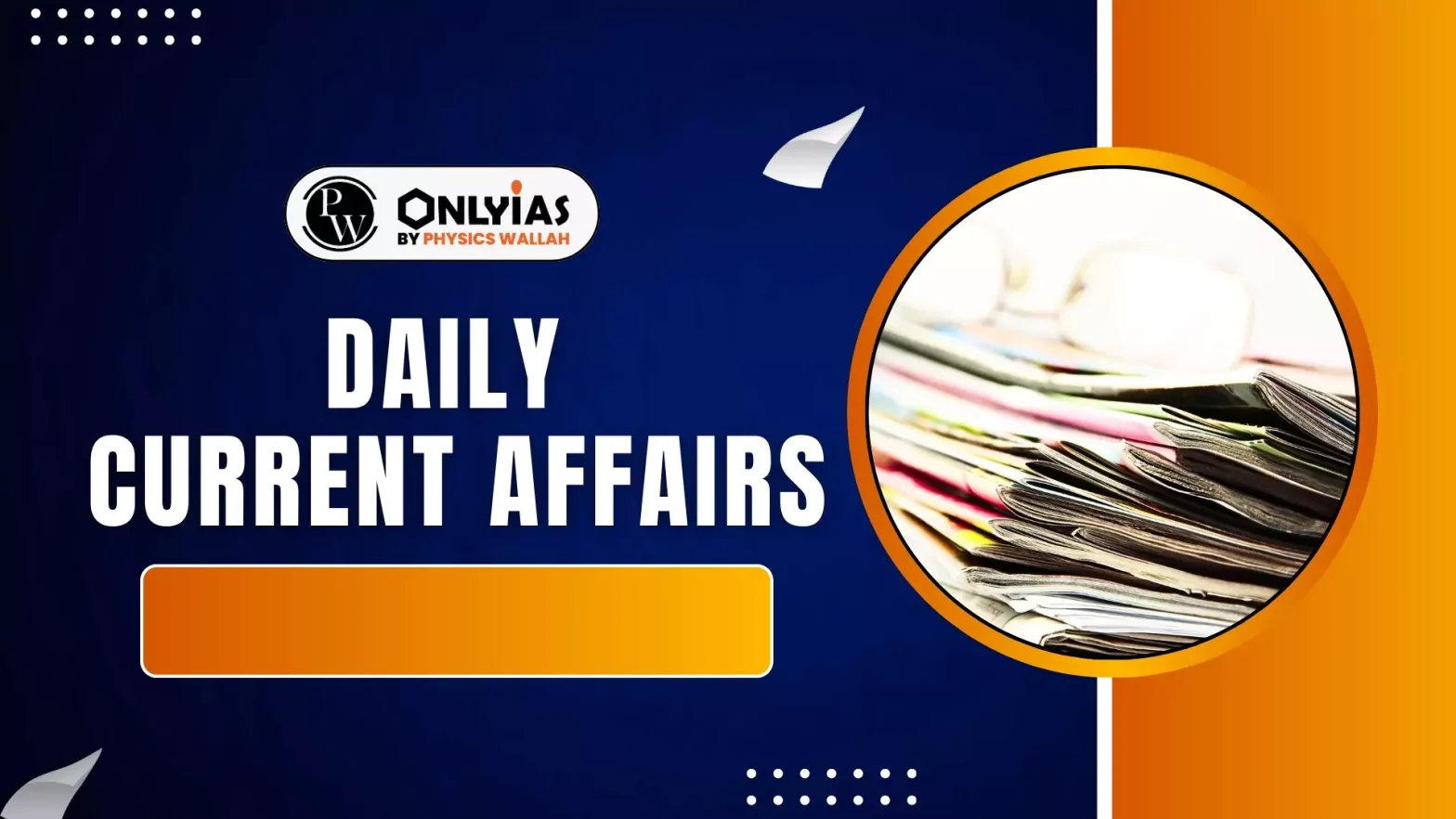

 Gender Disparity: Women’s participation has been rising with the success of athletes like P.V. Sindhu and Mary Kom, but there is still a cultural and institutional bias, especially in non-mainstream sports.
Gender Disparity: Women’s participation has been rising with the success of athletes like P.V. Sindhu and Mary Kom, but there is still a cultural and institutional bias, especially in non-mainstream sports.
 Allowances: Core group athletes receive ₹50,000/month; junior athletes in the Development Group get ₹25,000/month.
Allowances: Core group athletes receive ₹50,000/month; junior athletes in the Development Group get ₹25,000/month.